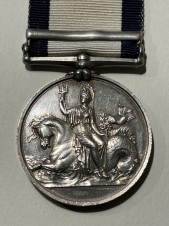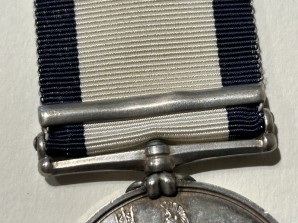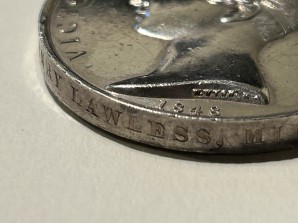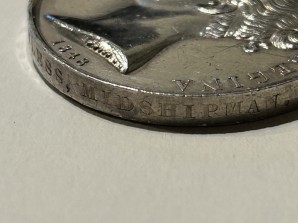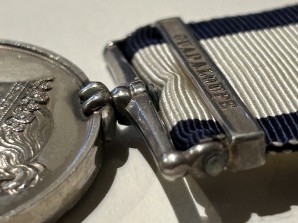NGS CLASP GUADALOUPE, HENRY LAWLESS , MIDSHIPMAN
Stock No. 132492
Product Information
Out of Stock
NGS MEDAL , CORRECT IN EVERY WAY – UNIQUELY NAMED
Commander Henry Lawless. Born 13th April 1792, St. Marylebone, London, being baptised on the 25th at St. Mary’s Marylebone. He entered the Navy in May 1807.
Copenhagen 1807
HMS Procris (brig-sloop 18) May to September 1807
First Class Volunteer. Commander Francis Beauman commissioned Procris in March 1807 for service in the North Sea. Took part in the attack to capture the Danish fleet at Copenhagen during August and September 1807. On the way out, on 30th August Procris and Cherub detained the Danish ship Neptunus. Procris is listed among the vessels qualifying for prize money arising out of the battle of Copenhagen.
HMS Inflexible (3rd rate 64) September 1807 to December 1808
Midshipman. Captain Joshua Rowley Watson. Lawless moved into her following the Copenhagen campaign – most probably when she was back at the Nore being re-commissioned.
HMS Éclair (sloop 18) December 1808 to 1809
Midshipman. Capt. Charles Kempthorne Quash. Sailed for the Mediterranean 20th February 1809. Took the Privateer La Revanche a French 8 Gun Privateer in the Mediterranean.
HMS Princess of Orange (3rd rate 74) 1809
Midshipman. flag-ship of Vice-Admiral Campbell. Probably on board for return to England.
HMS Perlen (frigate 38) May 1809 to 1812
Midshipman. Capt. Norbone Thompson. 38-gun frigate HMS Perlen, in which ship he assisted at the reduction of Flushing in June 1809 during the Walcheren Campaign. Sailed for the Leeward Islands 11th December 1809.
Capture of Guadeloupe 1810
Took part in the capture of Guadaloupe on 5th February 1810. (More research needed)
HMS Bombay (3rd rate 74) 1812 to October 1813
Midshipman. Followed Captain Norbone Thompson. Mediterranean. On return to England, he passed for Lieutenant on 5th July 1813.
West Indies
HMS Barham (3rd rate 74) October 1813 to January 1814
Midshipman. Capt. John Wm. Spranger. 26 Oct 1813 ship arrived Cork from Portsmouth with a small convoy, to join the main convoy, then sailed for Jamaica in the West Indies on the same day. Joined Argo on arrival.
HMS Argo (frigate 44) January 1814 to 28th April 1814
Midshipman and Lieutenant (27th April 1814). Captains Wm. Browne and Wm. Fothergill, Flagship of Rear Ad. W. Brown, at Jamaica on the West India station.
The Cockpit Duel
Thomas Walbeoff Cecil of HMS Argo, gained a moderate degree of notoriety on 28th April 1814 when, during a duel in Jamaica, he shot dead his fellow officer, Captain Hassard Stackpoole, captain of HMS Statira.
Apparently two officers of the Statira informed Captain Stackpoole, that Lt. Cecil “had declared in their presence, that he never spoke the truth.” (i.e. called him a liar) Three years elapsed from the alleged utterance of these words, until the captain and lieutenant met up at Jamaica. Stackpoole sent his first lieutenant with a message, demanding to know whether Cecil “had used such language, and if he had, it was impossible for both of them to exist in the same world together, for he should require satisfaction.” Cecil persisted that, “as far as he could recollect, he had never said anything of the kind; but as he might have made use of the words, he would not deny them.”
Captain Stackpoole required a positive denial in writing, or to meet him the next morning with pistols, and the second having thus far delivered himself of his errand, asked Mr. Cecil “if there was anything he could say to the captain, which might induce the latter to accept an apology.” To this Cecil replied, that “the message he had first received put it entirely out of his power to apologize, he much regretted that it had not been required at the outset, but now his only alternative was to give Capt. Stackpoole the meeting he demanded.”
About five o’clock (soon after daylight) on the succeeding morning the hostile parties met––took their ground at ten paces, and fired as nearly as possible at the same moment’.
Lord Byron, a close friend of Lt. Cecil stated: ‘They fought after a quarrel of three years. Captain Stackpoole was so good a shot that he used to cut off the heads of the fowls for dinner, as they drank out of the coops. Stackpoole had every wish to kill his antagonist, but he received his death-blow from Cecil, who fired rather fine, or, rather, was the quickest shot, of the two his ball entered Stackpoole’s right arm a little above the wrist, glanced off through his side, fracturing a rib, and passed into the lungs.
When Cecil, after both had fired, called out to him, ‘all’s right, sir,’ (implying that he, Cecil, was not wounded) the Stackpole’s arm gradually fell to his side, and he was propped up from falling by his own friend, assisted by Lieut. Cecil and his friend: he then shook hands with Lieut. Cecil, and died while they were carrying him to his boat, which was in waiting on the beach near to the spot of the fatal rencontre. Lieut. Cecil was considered by everyone upon the station, both on shore and afloat, to have acted so honourably on the occasion above adverted to, that he was, within a very short time, promoted to the rank of Commander (and captain) of the sloop Electra by the station admiral.
Sadly Cecil died of yellow fever in Port Royal. Jamaica on 24th October 1814, only six months after the duel.
Spelman Swaine appointed to command Statira on the death of Capt. Stackpoole.
HMS Statira (5th rate frigate 38) 29th April, 1814 to 5th April 1815.
Lieutenant. Capt. Spelman Swaine Lawless was transferred from the Argo to the Statira, at Jamaica, the day after the duel.
War of 1812
Statira returned to England from Jamaica, arriving with a convoy on 13th July 1814. Subsequently she departed for North America on 1st November, conveying Sir Edward Pakenham and Major-General Gibbs, with a number of other military officers, to Isle Dauphine, Louisiana for the assault on New Orleans. (Captain Swain was awarded £502 and 2 shillings for safely landing the party in America) Afterwards Statira proceeded to St. Mary’s and Bermuda.
Gen. Pakenham impatient as Captain Swaine of HMS Statira seems overly cautious and the journey across is taking longer than anticipated. Swaine shortens sails at night and runs from any sail on the horizon. Swaine is worried. American heavy frigates are bigger than his ship and fast enough to catch Statira. The USS Constitution and USS President have already defeated British frigates. Royal Navy fighting instructions order British frigates to never engage American frigates unless we have a two to one advantage.
Pakenham’s staff officers hear from Lt. Dalby, Statira’s first officer, how they are particularly concerned about a new American super-frigate, USS Relentless. Dalby’s frigate was sunk by Relentless a year earlier, along with another frigate and a ship-of-the-line in a titanic battle in which the American frigate escaped unscathed.
Shipwrecked
On sailing from Bermuda on escort to a convoy to join Sir Alexander Cochrane at Isle Dauphine, the Statira was lost. On the 26th Feb. 1815, at 10 am. the Statira struck upon a rock which was not recorded in the Admiralty charts, nor in any others that her commander knew of. All his endeavours to save her proved ineffectual, and she went down in about half an hour Fortunately, before she sank, the officers and crew were al transferred into one of the transports from the convoy. Captain Swaine and his officers returned to England as passengers on board the Asia (74) for his obligatory Court Martial. He was fully acquitted, as it was proven that the existence of the submerged rock was totally uncharted.
When the crew were dispersed, and the war with France coming to an end, Lawless was placed on half pay where he remained for the next 12 years.
On 17th January 1825, he married Miss Catherine Gask, of Bury Street, St. James’s, in the parish of Hanover Square, Middlesex – now part of central London.
Royal Naval Coast Blockade Squadron (Anti-smuggling)
HMS Ramillies (3rd rate 74) 17th February 1827 to 16th March 1830
Lieutenant. Capt. Hugh Pigot. Accepted a position in the Coast Blockade squadron. Downs 5 July 1828. Coast Blockade (Eastern) service. Portsmouth 19 Sep 1829.
On 13th April 1828, the Katherine Stewart Forbes, a vessel under a license from the British East India Company which sailed between Britain and Bombay found herself in difficulties approaching the Goodwin Sands. Boats launched from the Ramillies, managed to get all the passengers off in very difficult circumstances. The Admiralty allowed the owners to make several presentations and awards, and Henry received a letter of thanks from the Committee of Lloyds for boarding the Gull light vessel stationed on the Goodwin Sands, and firing her alarm signals, and the 13 men who crewed the boat under his command each received a guinea. The vessel was saved, and went on to have a long career, including becoming a convict ship sailing to van Diemen’s Land.
In March 1830 Ramillies was relieved by the Talavera, on Coast Blockade, as she required repairs.
HMS Talavera (3rd rate 72) 11th December 1830 to 30th April 1831
Lieutenant. Followed Capt. Hugh Pigot on his transfer to Talavera, still on coast blockade duties. Jul 1830 the Downs. 12 January 1831 near the Marine-parade, Dover, Lieutenant Thomas Ross and a Joseph Jacobs, both of HM ship Talavera, were assaulted by smugglers, and the Lieutenant was violently beaten and bruised. A reward of £50 was offered, for the conviction of the offenders. In 1830 the Admiralty decided to abolish coast blockade and the ships manning the stations at the Downs and at Newhaven paid off. Talavera paid off at the end of April 1831 when the Royal Naval Coast Blockade Squadron was abolished, and was re-commissioned as a guard ship as part of a squadron under Vice Admiral Codrington the following month.
The Coastguard
Coastguard. 30th April 1831 to 11th January 1832
With his time with the naval blockade squadron coming to an end, he was probably given the choice of going on half pay, or, due to his experience with the coast blockade, taking up a position as a naval officer attached to the Coastguard. He chose the latter option.
He was posted to the new Coastguard station at Pegwell Bay, Ramsgate, Kent as Chief Officer on 15th April 1831, then on to Cuckmere Haven, Newhaven on 31st August 1831. After serving on a large warship, he was probably not comfortable on such a small station (he had only seven staff – two less than at Pegwell Bay), so resigned from his position on 11th January 1832, after only some 9 months.
He reverted to half pay for the next 10 years, and lived at Oxford Buildings, Walcot, Bath, with wife Catherine.
Irish Coast Guard. 7th March 1843 to 28th January 1854.
Lieutenant. After just over 10 years on half pay, Henry accepted a position with the Coastguard stationed in Ireland, and moved along with Catherine to Clontarf, Dublin, where they remained for the rest of their lives – 11 years of which Henry commanded Coastguard stations.
He subsequently commanded the Irish Coastguard stations at Giles Quay, Dundalk, from 7th March 1843, Balbriggan, Dublin from 22nd April 1845, and Clontarf, Dublin, from 9th April 1850, until he was promoted to Commander and retired, on 9th January 1854.
Catherine died at Clontarf on 21st January 1863, and Henry himself died sometime between July and September 1865 at the age of 73.

